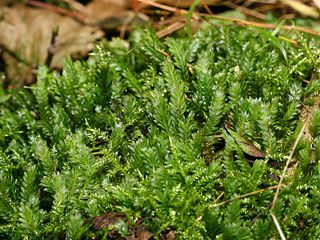
Fissidens adianthoides, the maidenhair pocketmoss, is a moss in the family Fissidentaceae. It was first collected by Hedwig in 1801.
Monoicy is a sexual system in haploid plants where both sperm and eggs are produced on the same gametophyte, in contrast with dioicy, where each gametophyte produces only sperm or eggs but never both. Both monoicous and dioicous gametophytes produce gametes in gametangia by mitosis rather than meiosis, so that sperm and eggs are genetically identical with their parent gametophyte.

Polytrichum commune is a species of moss found in many regions with high humidity and rainfall. The species can be exceptionally tall for a moss with stems often exceeding 30 cm (12 in) and rarely reaching 70 cm (27.5 in), but it is most commonly found at shorter lengths of 5 to 10 cm. It is widely distributed throughout temperate and boreal latitudes in the Northern Hemisphere and also found in Mexico, several Pacific Islands including New Zealand, and also in Australia. It typically grows in bogs, wet heathland and along forest streams. Additionally, class Polytrichopsida has been shown to thrive in partially open habitats that have been recently disturbed by human activities or even livestock.
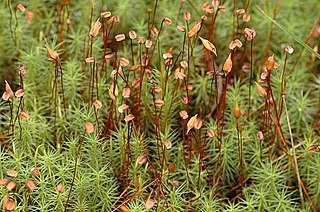
Polytrichaceae is a common family of mosses. Members of this family tend to be larger than other mosses, with the larger species occurring in particularly moist habitats. The leaves have specialized sheaths at the base and a midrib that bears photosynthetic lamellae on the upper surface. These mosses are capable of sustaining high rates of photosynthesis in the presence of ample light and moisture. Unlike all other mosses, the hydroid-based vascular system of these mosses is continuous from stem to leaf and can extract water from the soil through transpiration. Species in this group are dioicous, though some are monoicous. In most species, the sporophytes are relatively large, the setae are rigid, and the calyptrae are hairy. Most species have nematodontous peristomes with 32–64 teeth in their sporangium; some early-diverging genera instead have a stopper mechanism, which consists of the apical section of the columella, that seals the mouth of the capsule shut prior to dehiscence.

Tetraphidaceae is a family of mosses. It includes only the two genera Tetraphis and Tetrodontium, each with two species. The defining feature of the family is the 4-toothed peristome.

Polytrichum is a genus of mosses — commonly called haircap moss or hair moss — which contains approximately 70 species that have a cosmopolitan distribution. The genus Polytrichum has a number of closely related sporophytic characters. The scientific name is derived from the Ancient Greek words polys, meaning "many", and thrix, meaning "hair". This name was used in ancient times to refer to plants with fine, hairlike parts, including mosses, but this application specifically refers to the hairy calyptras found on young sporophytes. A similar naming related to hair appears in Old Norse, haddr silfjar, "hair of Sif", goddess from Norse Mythology, wife of the god Thor. There are two major sections of Polytrichum species. The first — section Polytrichum — has narrow, toothed, and relatively erect leaf margins. The other — section Juniperifolia — has broad, entire, and sharply inflexed leaf margins that enclose the lamellae on the upper leaf surface.

Fontinalis is a genus of submerged aquatic mosses belonging to the subclass Bryidae. These mosses are also called willow moss, fountain moss, brook moss and water moss. The genus is widespread in the Northern Hemisphere and includes both species that occur in still water and in flowing water.

Itatiella ulei is a species of moss in the family Polytrichaceae. It is the only species in the genus Itatiella. The Polytrichaceae is a common family of mosses that does not have close living relatives. Its small size and the inflexed leaf apex characterize Itatiella ulei. When this species grows directly exposed to sun at high elevations, it presents a similar aspect but can be distinguished based on the distal lamella cells which are single and rhombic.

Dawsonia is a genus of acrocarpous mosses. Dawsonia, along with other members of the order Polytrichales, are taller than most mosses and have thicker leaves. Their sporophytes have conducting systems analogous to those of vascular plants. Dawsonia superba is found in New Zealand, Australia and New Guinea. D. longifolia is found in the Philippines, Indonesia, Malaysia, and Australia. There is uncertainty as to whether D. superba and D. longifolia are actually distinct species.
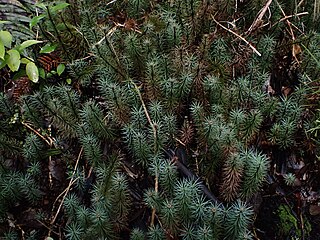
Dawsonia superba is a moss in the family Polytrichaceae that is found in Australia, New Guinea, Malaysia and New Zealand. D. superba is the tallest self-supporting moss in the world, reaching heights of 60 cm (24 in). It has analogous structures to those in vascular plants that support large size, including hydroid and leptoid cells to conduct water and photosynthate, and lamellae that provide gas chambers for more efficient photosynthesis. D. superba is a member of the class Polytrichopsida, although it has a sporophyte that is unique from other hair-cap mosses.

Splachnaceae is a family of mosses, containing around 70 species in 6 genera. Around half of those species are entomophilous, using insects to disperse their spores, a characteristic found in no other seedless land plants.

Pogonatum urnigerum is a species of moss in the family Polytrichaceae, commonly called urn haircap. The name comes from "urna" meaning "urn" and "gerere" meaning "to bear" which is believed to be a reference made towards the plant's wide-mouthed capsule. It can be found on gravelly banks or similar habitats and can be identified by the blue tinge to the overall green colour. The stem of this moss is wine red and it has rhizoids that keep the moss anchored to substrates. It is an acrocarpous moss that grows vertically with an archegonium borne at the top of each fertilized female gametophyte shoot which develops an erect sporophyte.
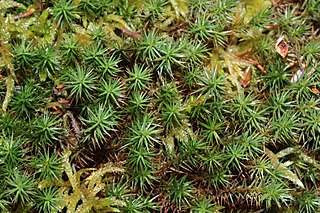
Polytrichum strictum, commonly known as bog haircap moss or strict haircap, is an evergreen and perennial species of moss native to Sphagnum bogs and other moist habitats in temperate climates. It has a circumboreal distribution, and is also found in South America and Antarctica.

Plagiomnium venustum, also known as magnificent leafy moss, is a species of moss belonging to the family Mniaceae. It is found mainly in western North America along the coastal region. This moss can be identified from other members of the Plagiomnium genus by dark coloured stomata guide cells and the absence of sterile stems. It is most commonly found growing as a mat on a variety of substrate, but mainly on humus and moist soil.

Orthotrichum lyellii, also known as Lyell's bristle moss, is a species of acrocarpous moss belonging to the family Orthotrichaceae. O. lyellii can be found throughout western North America and Europe. It is found most commonly growing epiphytically on a variety of trees, and less commonly on rocks or boulder substrates.

Andreaea rupestris is a species of moss in the class Andreaeopsida, are commonly referred to as the "lantern mosses" due to the appearance of their dehisced sporangia. It is typically found on smooth, acidic, exposed rock in the Northern hemisphere. It exhibits the common features of the genus Andreaea such as being acrocarpous, having dark pigmentation, lacking a seta, and bearing 4 lines of dehiscence in its mature sporangia, but can be further identified upon careful examination of its gametophytic leaves which have an ovate base to a more blunt apex compared to other similar species.

Polytrichastrum formosum, commonly known as the bank haircap moss, is a species of moss belonging to the family Polytrichaceae.
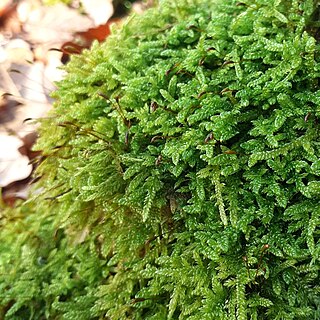
Hypnum is a genus of mosses belonging to the family Hypnaceae.

Polytrichum piliferum, the bristly haircap, is an evergreen perennial species of moss in the family Polytrichaceae. The bristly haircap moss is small-sized to medium-sized and forms loose tufts with wine-reddish stems. It is an acrocarpous moss that appears bluish-green to grey. This moss grows in clumps on erect shoots and becomes a red-brown colour as it grows older. The most distinguishing feature of P. piliferum is the long, white awn at the tips of the leaves, which also give this moss its grey colour. It is the only species in its genus where the awn is completely hyaline.

Andreaea blyttii, also commonly known as Blytt's rock moss, is a moss belonging to the family Andreaeaceae, commonly known as rock moss, granite moss, or lantern moss because of this family's unique sporangium. It is part of the genus Andreaea which is known for forming dark brownish or reddish-black carpets in high elevations. This species was first described by Schimper in 1855.



















